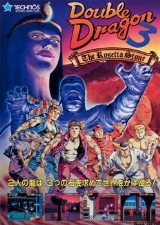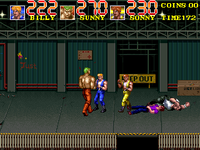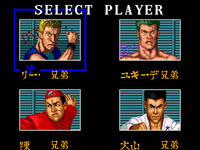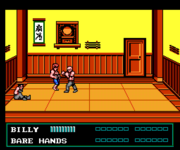
Double Dragon 3: The Rosetta Stone
Encyclopedia
is a side-scrolling beat 'em up
produced by Technos Japan Corp. that was originally released as a coin-operated arcade game
in . It is the second sequel to Double Dragon
for the arcades, following Double Dragon II: The Revenge
. A Nintendo Entertainment System
game loosely based on the arcade version was released, along with conversions for the Sega Mega Drive/Genesis, Game Boy
, and various computer platforms.
 The premise of Double Dragon 3 is explained on the game's attract sequence: while returning to their home from a training trip, Billy and Jimmy Lee cross paths with a fortune teller named Hiruko. The fortune teller cryptically tells the brothers that they must collect the three "Rosetta Stones" scattered around the world in order to face a mysterious new adversary awaiting them in Egypt. Depending on the game's configuration, up to two or three players can play the game (similar to The Combatribes, another beat-'em-up by Technos released during the same year). As usual, the first two players take control of Billy and Jimmy in that order, while the third player assumes the role of Sonny, a yellow-clad palette swap
The premise of Double Dragon 3 is explained on the game's attract sequence: while returning to their home from a training trip, Billy and Jimmy Lee cross paths with a fortune teller named Hiruko. The fortune teller cryptically tells the brothers that they must collect the three "Rosetta Stones" scattered around the world in order to face a mysterious new adversary awaiting them in Egypt. Depending on the game's configuration, up to two or three players can play the game (similar to The Combatribes, another beat-'em-up by Technos released during the same year). As usual, the first two players take control of Billy and Jimmy in that order, while the third player assumes the role of Sonny, a yellow-clad palette swap
of the Lee brothers.
The game uses a three-button control configuration like the previous titles, but discards the directional-based attack buttons from Double Dragon II, reverting back to the "Punch" and "Kick" setup of the first game. Most of the techniques from the first two titles are not featured in this installment such as the elbow punch and the hair pull, although new ones were added in their place such as a belly-to-back throw
and a running head-butt. There are also techniques that can be performed with another player character such as a back-to-back hurricane kick and a triangle jump kick. The player can also jump over fallen enemies.
Certain areas in the game feature weapon shops where the player can gain additional power-ups for their character such as new moves, agility, energy, and weapons, by inserting additional credits into the game. The player can also purchase new playable characters that will replace their current character when they're killed. There are at least three additional character types in addition to the default one that the player starts the game with: the Urquidez brothers, the Chin brothers, and the Oyama brothers.
The game is divided into five stages, each taking place in a different country: America, China, Japan, Italy, and Egypt. Each stage feature their own enemy characters that fit with the setting and motif (i.e: the enemies in Japan are swordsmen in a castle, with a ninja as the boss).
 The Japanese version of the Double Dragon 3 arcade game differs from the western release in that the player can select their character before starting the game. Players can choose between a Lee brother character or any of the other three featured character types (Urquidez, Chin, or Oyama). The weapon shops from the western release are not featured in the Japanese version, thus the two extra moves that could be purchased by the player in the western version (the hurricane kick and the one-armed headbutt) are available by default (although the hurricane kick is slightly more difficult to perform), while weapons can be found lying on the ground in certain stages (although, only the Lee brothers can use weapons).
The Japanese version of the Double Dragon 3 arcade game differs from the western release in that the player can select their character before starting the game. Players can choose between a Lee brother character or any of the other three featured character types (Urquidez, Chin, or Oyama). The weapon shops from the western release are not featured in the Japanese version, thus the two extra moves that could be purchased by the player in the western version (the hurricane kick and the one-armed headbutt) are available by default (although the hurricane kick is slightly more difficult to perform), while weapons can be found lying on the ground in certain stages (although, only the Lee brothers can use weapons).
 A Nintendo Entertainment System
A Nintendo Entertainment System
game loosely based on the arcade game, titled Double Dragon III: The Sacred Stones (or Double Dragon III: The Rosetta Stone in Japan) was released on February 22, in Japan and North America. As with the NES version of the second game, it was published by Technos in Japan and by Acclaim Entertainment
in North America
and the PAL region
.
The NES version of Double Dragon III follows the same premise as the arcade version. However, the game's script was completely rewritten for its English localization, with Billy and Jimmy being given a motive to help out Hiruko search for the Sacred Stones by having Marion (the heroine from previous games) disappear again. The final boss, originally a revived Cleopatra in the arcade and Famicom versions, is now identified as a possessed version of Marion named Queen Noiram.
The NES version features different gameplay than its arcade counterpart. The player can now switch characters through a sub-screen. The player starts out as Billy or Jimmy Lee, but gains two additional characters after defeating them as bosses thorough the course of the game: Chin Seimei (a Chinese martial artist) and Yagyu Ranzou (a Japanese ninja). Each character has a secondary weapon that can be used for a limited time after equipping it from the sub-menu. In addition, the player can also use weapons from enemies like previous Double Dragon games. Each character has only one life and the game ends when all of them die (a single continue is available for the last two missions).
The NES version of Double Dragon III is notable for its typo
of Billy's name as "Bimmy" in the opening intro of the 2 Players Mode. Also, the "America" setting in the first mission of the arcade version was corrected to the more accurate "U.S.A." setting.
) was released on August 1992, while the Mega Drive/Genesis port (developed by Software Creations
) was released on December 1992.
Computer ports of the Double Dragon 3 arcade game were also released in for the ZX Spectrum
, Amstrad CPC
, Commodore 64
, Amiga, Atari ST
, and IBM PC
, which were all developed by The Sales Curve
and published on their Storm label.
A handheld electronic game
was produced by Tiger Electronics
in 1988.
in Japan
, titled Double Dragon 3/The Combatribes. It was released on June 21, 1991 and its catalog number is PCCB-00065. Tracks 1 to 12 are taken from Double Dragon 3.
Beat 'em up
Beat 'em up is a video game genre featuring melee combat between the protagonist and a large number of underpowered antagonists. These games typically take place in urban settings and feature crime-fighting and revenge-based plots, though some games may employ historical or fantasy themes...
produced by Technos Japan Corp. that was originally released as a coin-operated arcade game
Arcade game
An arcade game is a coin-operated entertainment machine, usually installed in public businesses such as restaurants, bars, and amusement arcades. Most arcade games are video games, pinball machines, electro-mechanical games, redemption games, and merchandisers...
in . It is the second sequel to Double Dragon
Double Dragon
is a classic beat 'em up video game series initially developed by Technos Japan Corporation, who also developed the Kunio-kun series ....
for the arcades, following Double Dragon II: The Revenge
Double Dragon II: The Revenge
is a side-scrolling beat 'em up produced by Technos originally released as a coin-operated arcade game in . It is the sequel to Double Dragon, released during the previous year. A home version for the Nintendo Entertainment System was released in which differs drastically from the original arcade...
. A Nintendo Entertainment System
Nintendo Entertainment System
The Nintendo Entertainment System is an 8-bit video game console that was released by Nintendo in North America during 1985, in Europe during 1986 and Australia in 1987...
game loosely based on the arcade version was released, along with conversions for the Sega Mega Drive/Genesis, Game Boy
Game Boy
The , is an 8-bit handheld video game device developed and manufactured by Nintendo. It was released in Japan on , in North America in , and in Europe on...
, and various computer platforms.
Arcade version

Palette swap
A palette swap is a practice used in video games, whereby a graphic that is already used for one element is given a different palette, so it can be reused as other elements. The different palette gives the new graphic a unique set of colors, which make it recognizably distinct from the original...
of the Lee brothers.
The game uses a three-button control configuration like the previous titles, but discards the directional-based attack buttons from Double Dragon II, reverting back to the "Punch" and "Kick" setup of the first game. Most of the techniques from the first two titles are not featured in this installment such as the elbow punch and the hair pull, although new ones were added in their place such as a belly-to-back throw
Suplex
A suplex is an offensive move used in professional sport wrestling . The move consists of one wrestler picking up his or her opponent off the ground and then using a large portion of his or her own body weight to drive the opponent down on the mat. Nearly all suplexes have the attacker going down...
and a running head-butt. There are also techniques that can be performed with another player character such as a back-to-back hurricane kick and a triangle jump kick. The player can also jump over fallen enemies.
Certain areas in the game feature weapon shops where the player can gain additional power-ups for their character such as new moves, agility, energy, and weapons, by inserting additional credits into the game. The player can also purchase new playable characters that will replace their current character when they're killed. There are at least three additional character types in addition to the default one that the player starts the game with: the Urquidez brothers, the Chin brothers, and the Oyama brothers.
The game is divided into five stages, each taking place in a different country: America, China, Japan, Italy, and Egypt. Each stage feature their own enemy characters that fit with the setting and motif (i.e: the enemies in Japan are swordsmen in a castle, with a ninja as the boss).
Regional differences

Nintendo Entertainment System

Nintendo Entertainment System
The Nintendo Entertainment System is an 8-bit video game console that was released by Nintendo in North America during 1985, in Europe during 1986 and Australia in 1987...
game loosely based on the arcade game, titled Double Dragon III: The Sacred Stones (or Double Dragon III: The Rosetta Stone in Japan) was released on February 22, in Japan and North America. As with the NES version of the second game, it was published by Technos in Japan and by Acclaim Entertainment
Acclaim Entertainment
Acclaim Entertainment was an American video game developer and publisher. It developed, published, marketed and distributed interactive entertainment software for a variety of hardware platforms, including Sega's Mega Drive/Genesis, Saturn, Dreamcast, and Game Gear, Nintendo's NES, SNES, Nintendo...
in North America
North America
North America is a continent wholly within the Northern Hemisphere and almost wholly within the Western Hemisphere. It is also considered a northern subcontinent of the Americas...
and the PAL region
PAL region
The PAL region is a television publication territory which covers most of Asia, Africa, Australia, New Zealand, and most of Western Europe...
.
The NES version of Double Dragon III follows the same premise as the arcade version. However, the game's script was completely rewritten for its English localization, with Billy and Jimmy being given a motive to help out Hiruko search for the Sacred Stones by having Marion (the heroine from previous games) disappear again. The final boss, originally a revived Cleopatra in the arcade and Famicom versions, is now identified as a possessed version of Marion named Queen Noiram.
The NES version features different gameplay than its arcade counterpart. The player can now switch characters through a sub-screen. The player starts out as Billy or Jimmy Lee, but gains two additional characters after defeating them as bosses thorough the course of the game: Chin Seimei (a Chinese martial artist) and Yagyu Ranzou (a Japanese ninja). Each character has a secondary weapon that can be used for a limited time after equipping it from the sub-menu. In addition, the player can also use weapons from enemies like previous Double Dragon games. Each character has only one life and the game ends when all of them die (a single continue is available for the last two missions).
The NES version of Double Dragon III is notable for its typo
Typographical error
A typographical error is a mistake made in, originally, the manual type-setting of printed material, or more recently, the typing process. The term includes errors due to mechanical failure or slips of the hand or finger, but usually excludes errors of ignorance, such as spelling errors...
of Billy's name as "Bimmy" in the opening intro of the 2 Players Mode. Also, the "America" setting in the first mission of the arcade version was corrected to the more accurate "U.S.A." setting.
Other platforms
In addition to the NES game, Acclaim also released two home versions of Double Dragon 3 in North American and Europe that were direct conversions of the arcade game. The Game Boy version (developed by Sales CurveSCi
Square Enix Limited, doing business as Square Enix Europe, is a British publisher of video game software wholly owned by Square Enix. Square Enix Europe has its head office in the Wimbledon Bridge House in Wimbledon, London Borough of Merton....
) was released on August 1992, while the Mega Drive/Genesis port (developed by Software Creations
Software Creations
Software Creations can refer to one of two companies:* Software Creations , an Internet development consulting firm specializing in electronic publishing, web-based database and applications development...
) was released on December 1992.
Computer ports of the Double Dragon 3 arcade game were also released in for the ZX Spectrum
ZX Spectrum
The ZX Spectrum is an 8-bit personal home computer released in the United Kingdom in 1982 by Sinclair Research Ltd...
, Amstrad CPC
Amstrad CPC
The Amstrad CPC is a series of 8-bit home computers produced by Amstrad between 1984 and 1990. It was designed to compete in the mid-1980s home computer market dominated by the Commodore 64 and the Sinclair ZX Spectrum, where it successfully established itself primarily in the United Kingdom,...
, Commodore 64
Commodore 64
The Commodore 64 is an 8-bit home computer introduced by Commodore International in January 1982.Volume production started in the spring of 1982, with machines being released on to the market in August at a price of US$595...
, Amiga, Atari ST
Atari ST
The Atari ST is a home/personal computer that was released by Atari Corporation in 1985 and commercially available from that summer into the early 1990s. The "ST" officially stands for "Sixteen/Thirty-two", which referred to the Motorola 68000's 16-bit external bus and 32-bit internals...
, and IBM PC
IBM PC
The IBM Personal Computer, commonly known as the IBM PC, is the original version and progenitor of the IBM PC compatible hardware platform. It is IBM model number 5150, and was introduced on August 12, 1981...
, which were all developed by The Sales Curve
SCi
Square Enix Limited, doing business as Square Enix Europe, is a British publisher of video game software wholly owned by Square Enix. Square Enix Europe has its head office in the Wimbledon Bridge House in Wimbledon, London Borough of Merton....
and published on their Storm label.
A handheld electronic game
Handheld electronic game
----Handheld electronic games are very small, portable devices for playing interactive electronic games, often miniaturized versions of video games. The controls, display and speakers are all part of a single unit. Rather than a general-purpose screen made up of a grid of small pixels, they...
was produced by Tiger Electronics
Tiger Electronics
Tiger Electronics is an American toy manufacturer, best known for its handheld LCD games, the Furby, and Giga Pets. When Tiger was an independent company, Tiger Electronics Inc., its headquarters were in Vernon Hills, Illinois....
in 1988.
Soundtrack
An album containing the original soundtrack for the arcade versions of this game and The Combatribes was released by Pony CanyonPony Canyon
is a Japanese company, established on October 1, 1966 , which publishes music, DVD and VHS videos, movies and video games. It is a subsidiary of Japanese Media Group, Fujisankei Communications Group.-History:...
in Japan
Japan
Japan is an island nation in East Asia. Located in the Pacific Ocean, it lies to the east of the Sea of Japan, China, North Korea, South Korea and Russia, stretching from the Sea of Okhotsk in the north to the East China Sea and Taiwan in the south...
, titled Double Dragon 3/The Combatribes. It was released on June 21, 1991 and its catalog number is PCCB-00065. Tracks 1 to 12 are taken from Double Dragon 3.
- "The Rosetta Stone" (arranged version)
- "The Rosetta Stone"
- "To the Dragon World"/"In America"/"The New Black Warriors"
- "Jim's Theme"/"The Way of Sōsetsuken"
- "To the Dragon World"/"In China"/"Li's Theme"
- "To the Dragon World"/"In Japan"/"Ranzou's Theme"
- "To the Dragon World"/"In Italy"/"Giuliano's Theme"
- "To the Dragon World"/"The Enchanted Forest"/"Enter the Dragon"
- "The Fearsome Goblin"/"Roppe, the Stone Man"/"Hiruko's Trap"
- "Awakening of the 2,000 Years Old Demon"/"Cleopatra's Theme"
- "To the Children of the World"
- "Play Version"
- "The Final Battle" (arranged version)
- "Title Roll"/"The Motorcycle Nuclear Warheads"/"2X4 Fatman"/"Go to next Act"
- "Amusement Park Nightmare"/"Persian Warlord"
- "The Slash Skate Screamers"/"Destroy Overdrive"
- "Place of S.O.D."/"War Paint"
- "The Slaughter Troops"/"Swastika is Cyborg"
- "The Final Battle (Martha Splatterhead)"
- "Ending (Out of Somewhere)"/"Staff Roll (Rest in Peace)"
- "Play Version"

